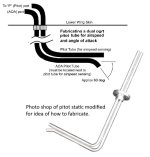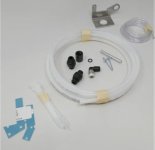gmcjetpilot
Well Known Member
I have some options for Pitot AOA probe. GRT Avionics EFIS suggest fabricate this. Any suggestions of your DIY fabrication?

The other option is make pitot per Van's planes, works well, and add AOA to LE of wing like RV-12. Question is how well will it work? Any one try RV12 AOA in RV4/RV6/RV7/RV8 wing. If I was sure this would work this would likely go to #1. It only needs to angle down about 60 Deg from chord line. The DIY above can be modified.

The third option is buy Dynons unheated or heated AOA which is going to be about $640, about $300 less unheated.
Dynon heated and unheated, plus a bracket, aerodynamic shape extruded tube, cool but overkill for what I want, size, weight.
NOTE other threads like https://vansairforce.net/threads/angle-of-attack-indicators.156794/
...

The other option is make pitot per Van's planes, works well, and add AOA to LE of wing like RV-12. Question is how well will it work? Any one try RV12 AOA in RV4/RV6/RV7/RV8 wing. If I was sure this would work this would likely go to #1. It only needs to angle down about 60 Deg from chord line. The DIY above can be modified.

The third option is buy Dynons unheated or heated AOA which is going to be about $640, about $300 less unheated.
Dynon heated and unheated, plus a bracket, aerodynamic shape extruded tube, cool but overkill for what I want, size, weight.
NOTE other threads like https://vansairforce.net/threads/angle-of-attack-indicators.156794/
...
Last edited:




